ExoMars 2016 – Mission Overview
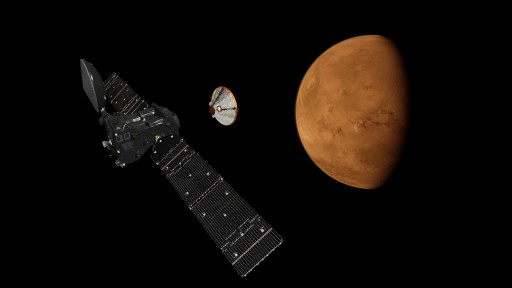
The ExoMars 2016 Mission aims to deliver to Mars the Trace Gas Orbiter for a multi-year mission studying the Martian atmosphere and the Schiaparelli lander for a critical re-entry and landing demonstration followed by a short surface science mission.
The ExoMars 2016 mission has a launch window stretching from March 14 to 25, 2016, lifting off from Site 200/39 at the Baikonur Cosmodrome, Kazakhstan atop a Proton-M/Briz-M launch vehicle. Inserted into an interplanetary transfer trajectory, ExoMars 2016 will enter a seven-month coast filled with a number of course correction maneuvers to fine-tune its path to the Red Planet.
Three days prior to the arrival at Mars, the Schiaparelli lander will separate from the Trace Gas Orbiter, being delivered to a hyperbolic trajectory intercepting the Martian atmosphere for re-entry and landing at Meridiani Planun on October 19, 2016. While Schiaparelli descends to the surface of Mars, TGO will complete its critical orbital insertion maneuver, entering an elliptical orbit around Mars.
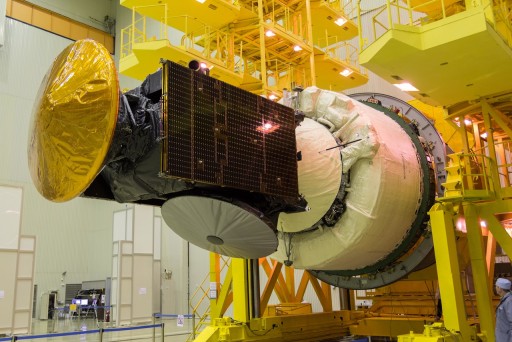
Schiaparelli will operate for only four sols (=Martian days) and the mission counts on TGO providing communications relay during this mission phase to deliver data gathered on the surface of Mars to Earth. In December, TGO completes orbital adjustment maneuvers – changing inclination to 74° and lowering the apoapsis of its orbit to set up for nine months of aerobraking – skimming the very upper atmosphere when at the low-point of its orbit to slow down and as a result bring down the high-point of the orbit. Science operations are expected to start in December 2017 and will last until December 2022.
While carrying out its exploration mission, TGO will serve as a communications terminal in Mars orbit, picking up data from the NASA Mars Rovers as well as the ExoMars 2018/20 rover and sending it back to Earth, also delivering data and commands from Earth to the rovers.
Launch & Ascent
>>Detailed ExoMars Countdown, Launch & Ascent Overview
>>Proton-M Launch Vehicle Overview
>>ExoMars 2016 Launch Timeline
Cruise to Mars
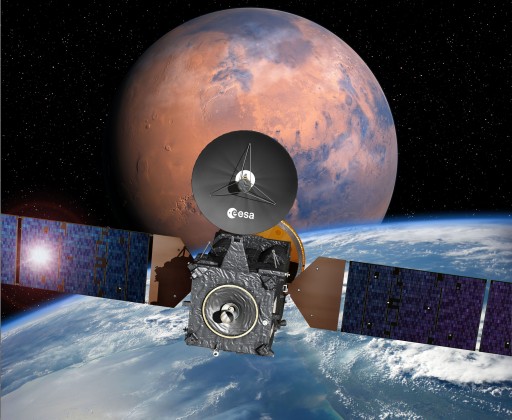
Completing its ten-hour and 41-minute ride atop the Proton-M rocket and its Briz-M upper stage, ExoMars 2016 will have a long path ahead – 500 million Kilometers to Mars. The first steps after spacecraft separation are the stabilization of the spacecraft’s orientation, initially using its sun sensors and gyroscopes to reduce body rates with the thrusters before later transitioning to Reaction Wheel control in a stable sun-pointed attitude. Solar array deployment is completed as soon as the spacecraft has reached a stable orientation.
The first contact with ground stations is expected 76 minutes after spacecraft separation through the 2-meter tracking station in Malindi, Kenya. The Mission Control Team at the European Spaceflight Operations Center in Germany use the first data delivered by the spacecraft to conduct a basic check of its core functions, ensuring it is in a safe state and ready for initial flight operations. A test command is issued 32 minutes after acquisition of signal to verify ExoMars can receive signals from the ground.
In charge of communications relay and tracking during the first days of the ExoMars 2016 mission are the 15-meter ground stations in Maspalomas, Spain, and Kourou, French Guiana. Maspalomas is tasked with collecting radiometric data for an initial trajectory assessment, verifying that Briz-M delivered the spacecraft to the expected trajectory.
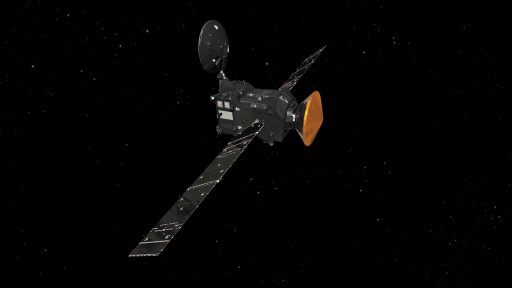
Within the first 24 hours, the Trace Gas Orbiter will deploy its 2.2-meter High-Gain Antenna, though its first use will not come until Launch +14 days as Low-Gain comms provide sufficient data speeds while the craft is still close to Earth. ExoMars is expected to finish its initial set of checkouts and reconfigurations within three days of liftoff to transition to its commissioning phase featuring more advanced tests and the activation of the science payload.
Called up for the cruise to Mars are the 35m-diameter deep-space tracking stations at Malargüe, Argentina, and New Norcia, Australia to handle communications with TGO throughout its seven-month transfer to Mars. The two stations provide 24-hour coverage for communications and tracking.
Per the mission plan, ExoMars will have the opportunity of conducting a Trajectory Correction Maneuver at Launch +7 days to remove launch vehicle insertion errors and set up the proper trajectory for the Deep Space Maneuver. If needed, this maneuver would use the smaller 10-Newton thrusters installed on the spacecraft.
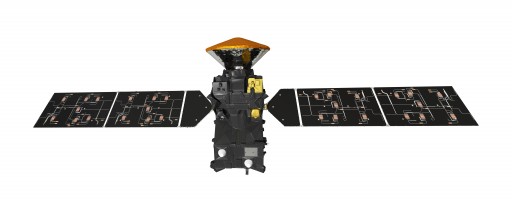
The ExoMars commissioning phase lasts until April 24 and includes detailed checks of the Trace Gas Orbiter carried out from ESOC and the ESAC facility in Spain while checkouts of Schiaparelli are managed from Thales Alenia in Italy.
In early April, the NASA radio transponder is powered up for a test to verify interference-free operation of the imaging payload of the orbiter while in communication with NASA and ESA ground stations. This will be crucial when TGO assumes its role as orbital communications terminal, delivering data relay to and from NASA and ESA rovers on the surface of Mars.
Until the end of June, TGO is in a quiet cruise mode with only three communications sessions per week, being kept in a safe configuration by the Mission Team.
A one-month campaign begins in mid July to determine the spacecraft’s precise trajectory through Delta-DOR – Delta Differential One Way Ranging. Ranging data is then used to calculate the critical Deep Space Maneuver set for July 28 – marking the first use of the spacecraft’s main engine.
The first ignition of the S400 main engine is preceded by the pressurization of the propulsion system by firing a series of pyrovalves. The Deep Space Maneuver is budgeted for a change in velocity of 326m/s to line the spacecraft up for Mars Orbit Insertion. A clean-up maneuver to correct any DSM errors is available 14 days after the Deep Space Maneuver.
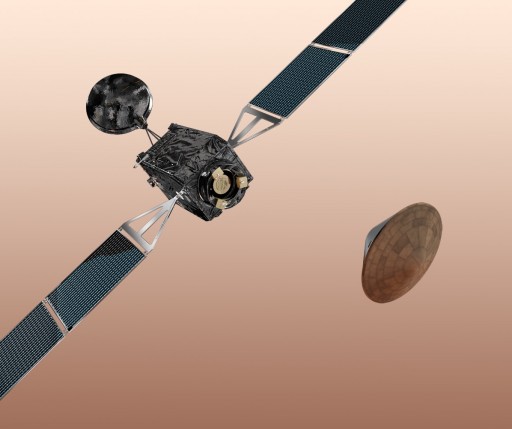
Operations will ramp up in September when daily communications sessions resume to mark the start of Orbit Insertion preparations. A Trajectory Correction Maneuver 30 days ahead of arrival can be used for fine-tuning of the spacecraft’s trajectory and another TCM is available at MOI-5 Days to set up the proper trajectory for Schiaparelli’s landing.
The lander receives its final set of commands in the days leading up to arrival, containing all operational sequences for the Entry, Descent and Landing phase as well as the four-sol surface mission.
Separation of the Schiaparelli Lander is planned at 14:42 UTC on October 16 using a three-point separation system pushing TGO and EDM apart at a relative velocity of over 30 centimeters per second and supplying a 2.5RPM spin rate to the lander for stabilization. Separation can be confirmed through telemetry as well as a change in the Doppler received from the spacecraft due to the slight change in velocity by the separation pushers.
Schiaparelli enters a hibernation mode very shortly after separation, to wake up only 75 minutes ahead of re-entry to save as much battery power as possible for the surface mission. The wake-up of the lander is triggered by a triple-redundant timer, ensuring EDM powers up at the right time to get ready for its blazing re-entry.
For the Trace Gas Orbiter, the departure of Schiaparelli means to enter its own preparations for Mars Orbit Insertion. A critical step comes 12 hours after EDM separation when the orbiter has to make an Orbit Raising Maneuver, moving from a trajectory intercepting the Martian Atmosphere to a safe passage several hundred Kilometers above the surface.
Should any issues arise with the separation of the lander, a backup slot exists on October 17. In case the separation fails altogether, ExoMars will have to take a detour, making a flyby of Mars to set up for orbit insertion two years later.
October 19, 2016 is the big day for Schiaparelli and the Trace Gas Orbiter – each set for the most critical maneuvers of their mission.
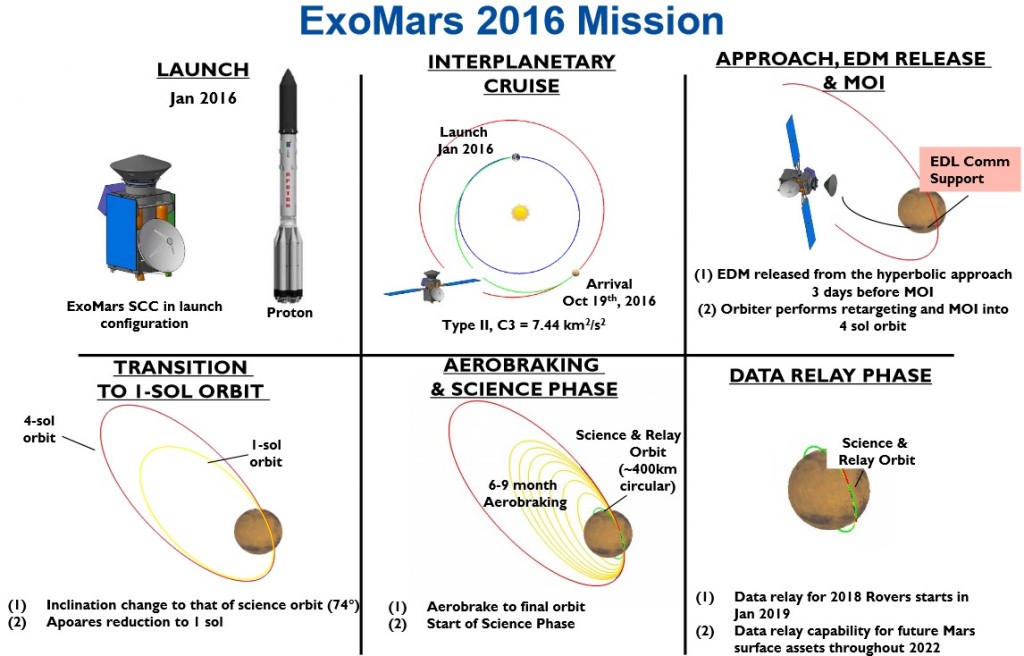
Entry, Descent & Landing
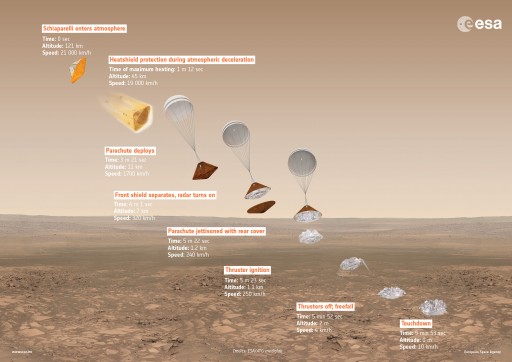
The 600-Kilogram Schiaparelli lander wakes up from hibernation 75 minutes prior to re-entry, giving it enough time to initialize its landing software and use the Sun Sensors to determine its orientation in space and from that generate an inertial reference frame for the Gyroscopes, the primary guidance data source during the early entry portion. Entry Interface occurs at 14:42 UTC when EDM passes 122.5 Kilometers in altitude, traveling around 21 000 Kilometers per hour, entering at an angle of 1.1 degrees.
One minute and 12 seconds after encountering the first traces of the Martian atmosphere, Schiaparelli will endure peak heating with temperatures on the heat shield reaching 1,750°C. At that point, the lander still travels at 19 000 km/h and is 45 Kilometers in altitude.
Parachute Deployment is expected at an altitude of 11 Kilometers and a speed around Mach 2, approximately three minutes and 12 seconds after Entry Interface. The 12-meter chute slows the vehicle down to around 80 meters per second.
When passing 7 Kilometers in altitude, the Heat Shield will be separated so that the Doppler Radar Altimeter can acquire the ground and deliver altitude and velocity measurements to the guidance system.
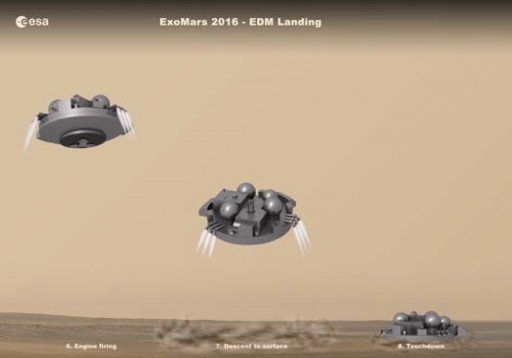
Five and a half minutes after re-entry, when reaching 1.2 Kilometers, the EDM Surface Platform separates from its Back Shield and ignites its nine landing thrusters one second thereafter. The 400-Newton thrusters, operated in pulse mode for proper attitude control, will fire for a total of 30 seconds, slowing the vehicle from 250 to 7 Kilometers per hour, reaching a position 1.5 meters above the surface. At that point, the engines will shut down and the lander will free fall for a landing at a speed of 11km/h. A crushable structure at the bottom of the lander will absorb some of the shock at landing to ensure the surface science equipment survives touchdown.
Throughout its re-entry and landing sequence, Schiaparelli will continuously send telemetry data via UHF antennas on the Back Shield and the Surface Platform. In orbit around Mars, the Mars Express spacecraft will listen for the signals and relay them to the ground around 60 minutes after landing to provide confirmation of the lander’s fate. The signal travel time at the time of landing will be 9 minutes and 45 seconds.
The ultra-weak UHF signals arriving at Earth will be recorded by the Giant Metrewave Radio Telescope Array in India to deliver a confirmation of landing as quickly as possible.
TGO Orbit Insertion
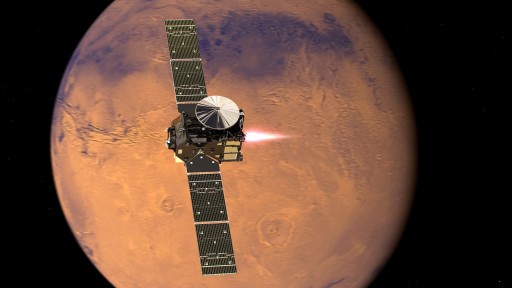
October 19 starts for the Trace Gas Orbiter with a seat in the front row, tasked with recording the UHF feed from Schiaparelli to store all data sent during the landing which is needed for engineering and scientific assessments. Playback of the data will take some time and results will not be available until several hours after the landing attempt.
More critical for TGO itself is the retrograde Mars Orbit Insertion burn that has to slow the spacecraft down sufficiently to be captured in orbit around the planet. The 134-minute burn of the 424-Newton engine is expected to start at 13:09 UTC, aiming for a delta-v of 1550 meters per second.
The Mars Orbit Insertion maneuver aims for an orbit of 298 by 95,856 Kilometers with a period of four sols.
Orbit Adjustments
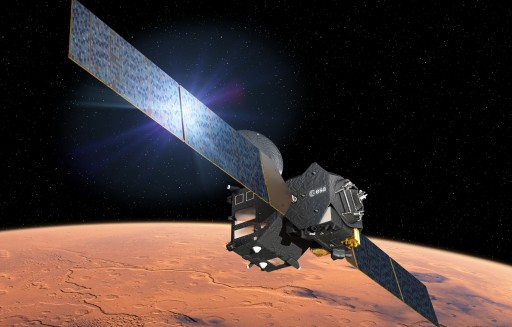
Arriving in its highly elliptical insertion orbit, TGO has to go through a lengthy orbit adjustment campaign to reach its operational science orbit of 400 x 400 Kilometers at a 74-degree inclination.
Starting in December 2016, TGO completes a series of inclination adjustment maneuvers to reach the desired orbital inclination and set up for a retrograde engine burn in January 2017 that will bring down the apoapsis of the orbit to reduce the orbital period from four to one sol.
From January to November 2017, TGO completes an aerobraking campaign – that is skimming the outermost layers of the Martian atmosphere to slow down and in turn reduce the apoapsis altitude. When passing through the upper reaches of the atmosphere, TGO uses its solar arrays as sails to generate drag and will need around six to nine months to reach the desired science orbit.
Science Operations
The Trace Gas Orbiter will initiate regular science activities in December 2017 operating its four instruments to study the Martian atmosphere. The science phase is expected to last through 2022 and beyond if the orbiter’s health permits. As part of regular operations, TGO will be tasked with data relay from Mars Surface Missions – NASA’s rovers and InSight lander, the ExoMars 2020 rover, and the ExoMars 2020 landing platform.
